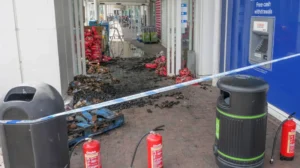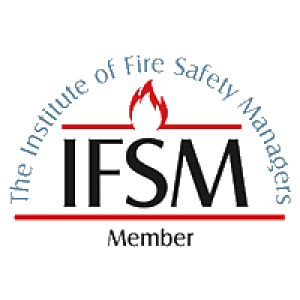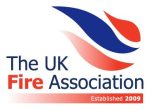You walk through them every day without thinking.
But when it comes to fire doors, many of us in UK workplaces don’t realise how crucial they are — or how often they’re being misused.
A recent survey found that 34% of UK office workers don’t know how fire doors should be kept when not in use.
That’s one in three people who aren’t aware that fire doors must be kept closed to work effectively — unless fitted with an approved automatic closing mechanism.
And considering that fire doors are one of the most important passive fire protection tools in any building, that’s a worrying statistic.
Let’s break down what this means, what the rules are, and how your workplace can stay safe and compliant without the jargon.
🚪 What Is a Fire Door — and Why Should You Care?
A fire door isn’t just a heavy door with a blue sign on it. It’s a carefully engineered piece of life-saving kit.
A properly fitted fire door can hold back fire and smoke for 30 to 60 minutes, giving people time to escape and the fire brigade time to respond.
It works by:
- Sealing off areas to prevent the spread of flames and smoke
- Automatically closing to block escape routes from filling with smoke
- Resisting heat thanks to special materials like intumescent strips and reinforced hinges
But here’s the thing: none of that works if the door is propped open, damaged, or badly fitted.
And yet, according to data from the Fire Door Inspection Scheme, a staggering 75% of fire doors in the UK don’t meet the required standards. Even worse, 31% were installed incorrectly from day one.
(Source: FIREX Global)
🚨 Common Problems People Don’t Notice
CE Safety surveyed 1,000 UK office workers, showing them potential fire door faults. Here’s what they found:
- 80% knew fire doors should be kept closed — great start
- But only 57% realised that cracked glass in a fire door was a serious issue
- Just 22% spotted gaps around the frame as a problem
- Only 13% flagged missing screws
- And 9% thought damaged hinges were cause for concern
These issues may sound small, but they can completely compromise the door’s ability to stop smoke and flames. Hinges, seals, and fixings need to be heat-resistant and properly fitted. Even a small gap or missing screw could allow deadly smoke to pass through.
“Smoke causes more fire-related deaths than fire itself.”
— CE Safety
What Are the Rules for Fire Doors in the UK
In the UK, fire door safety falls under the Regulatory Reform (Fire Safety) Order 2005. If you’re responsible for a commercial property, office, school, or shared residential building, you must:
- Ensure fire doors are inspected regularly (recommended every 6 months)
- Fix or replace faulty fire doors immediately
- Make sure staff are trained on how fire doors work and how to use them properly
Guidance from the Fire Door Inspection Scheme (FDIS) and BS 8214:2016 outlines how fire doors should be installed, maintained, and checked.
Fire Doors Myths & Misunderstandings
The same survey revealed some eyebrow-raising misunderstandings about fire door use in the workplace:
- 41% of workers had seen a fire door propped or wedged open (this is only safe with a certified automatic release mechanism)
- 17% had seen fire doors locked (which could be dangerous unless it’s an internal security door with a manual override in emergencies)
- A whopping 35% had not been shown the full fire exit route from their workplace
In London, nearly half (47%) of employees hadn’t seen the fire escape route.
In contrast, 91% in Northern Ireland had been properly briefed.
So… What Does a Fire Door Look Like When It’s Working Properly?
A compliant fire door should:
- Close fully on its own without slamming
- Have clearly visible intumescent and smoke seals
- Show no gaps larger than 3mm around the edges
- Be fitted with strong hinges and secure fixings
- Have a clear fire door sign (usually blue and white)
- Not be damaged, warped, or cracked
- Not be propped open (unless using an approved door holder that releases on alarm)
Who’s Responsible for Checking Fire Doors
There should always be a designated Responsible Person (as required by the Fire Safety Order) who ensures regular inspections and maintenance of fire doors. This could be the business owner, facilities manager, landlord, or another appointed person.
But as CE Safety’s spokesperson Gary Ellis says:
“Ideally, everyone should know how fire doors should be kept when not in use, as well as common problems that can arise with them. The more people are aware, the faster any issues will get reported.”
In other words, fire safety is a team effort.
Want to Learn More or Book a Fire Door Inspection?
At ESI: Electrical Safety Inspections, we carry out fire door inspections across Farnborough, Camberley, Aldershot, and the wider Surrey, Hampshire, and Berkshire area. Our friendly team provides:
- Clear, photographic reports
- Simple explanations — no jargon
- Support with remedial works and fire safety compliance
- Multi-service packages, including fire alarm servicing and EICRs
We believe fire safety shouldn’t be overwhelming. It should be clear, actionable, and accessible to everyone in your organisation — from directors to receptionists.
🛠 Final Thoughts
You don’t have to be a fire safety expert to protect your people. But knowing the basics — like the importance of keeping fire doors shut, what faults to look out for, and who’s responsible — could make a life-saving difference.
The next time you walk past a fire door at work, take a second to check it’s doing its job. It’s one of the quietest, simplest tools in fire protection — and one of the most powerful when it matters most.











